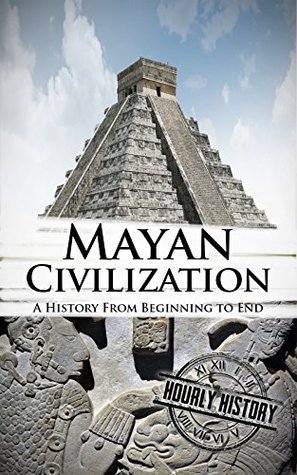More on this book
Community
Kindle Notes & Highlights
Read between
January 1 - January 1, 2018
The Mayan civilization perceived a highly-structured cosmos, reflected in most aspects of their practices and societies.
The ceiba tree grew deep in the Central American rainforest. It was sacred. The Maya considered it the first tree or the world tree.
The ceiba tree is a national symbol of Guatemala and was declared the national tree of the country in 1955, in part because of its importance to the Maya.
when the Spanish arrived in the 1580s, along the Caribbean coast, a Franciscan priest and his secretary Antonio de Ciudad Real asked some Indians, "What's the name of this place? How did it get its name?" In response, the Indians said uic athan, which means, “what do you say” or “what do you speak?” In other words, the Maya didn't understand them. Ciudad Real wrote, "The Spaniard ordered it set down to be called Yucatan."
There are even extant Maya codices that have been preserved that suggest prophetic stories led to Montezuma surrendering to Cortes, with the Aztec ruler’s own diviners predicting the European invasions.
Additionally, the Mayan sacred text, the Book of Chilam Balam, foretold the Spanish invasion, the conquest of the Maya and future suffering of the oppressed people. According to many experts, the prophet Chilam Balam anticipated the arrival of Spaniards and Christianity in order to prepare them for imminent change.
In early 2016, Pope Francis during his visit to San Cristobal Da Las Casas, Mexico, cited the Popol Vuh and said a few words in one of the native indigenous Maya languages to a crowd during a ceremony that included women chanting hymns in the Chol, Tzotzil, and Tzeltal Mayan languages. According to press reports, the Pope said, “On many occasions, in a systematic and organized way, your people have been misunderstood and excluded from society. Some have considered your values, culture, and traditions to be inferior. Others, intoxicated by power, money and market trends, have stolen your lands
...more
The Maya did not emerge from the lost tribes of Israel or Atlantis. Instead, based on overwhelming evidence from linguistics, physical anthropology, and archaeology, ancestors of all New World people, including the Maya, migrated from Asia as nomadic hunters and gatherers.
The Pre-Classic Era is considered to represent the Maya developments from 2000 BCE-250 BCE. The Classic Era includes 250 CE-900 CE. The Post-Classic Era includes 900 CE to 1697 CE.
The Mayan civilization was intimately tied to the Olmecs, a civilization which essentially vanished in 300 BCE.
the kings believed they had a divine covenant with the gods and their ancestors. The ruler was often depicted as the World Tree, which was a conduit by which humans communicated with the Otherworld.
The Maya lived in three separate sub-areas with distinct environmental and cultural differences: the northern Maya lowlands on the Yucatan Peninsula; the southern lowlands in the Peten district of northern Guatemala and adjacent portions of Mexico, Belize and western Honduras; and the southern Maya highlands, in the mountainous region of southern Guatemala. The southern region reached its peak during the Classic Era.
Some of their first large city-states (of the sixty or so known city-states throughout the Maya territory) like El Mirador in northern Guatemala date back to the Pre-Classic era.
The Danta complex in El Mirador is the largest Mesoamerican pyramid.
One of the first freeway systems in the world ran from El Mirador to Nakbe.
These kingdoms, beginning in the fifth century, organized themselves into great alliances headed by the kingdoms of Tikal and Kalak'mul. During this time, the alliance between Teotihuacan and Tikal grew. Tikal at the time was known as Mutul. Its temples rose 230 feet into the sky. Its
He further explained that Classic Maya rulers took jaguar names in various city-states and that Mayan gods and kings wore jaguar-skin kilts, capes, and sandals. According to Rod Preece in "Animals and Nature: Cultural Myths, Cultural Realities," Maya exported jaguar pelts for luxury uses.
Since one of the central goals of Maya city-states was to lord over each other's dominions and to increase their territory, the Maya devoted a great deal of resources to war.
During the Classic period, they practiced K'uhul Ajaw, which translates to "Holy Lords," to promote a system of competitive states substantiated by religious, military and political power that was heavily dependent on political ideology and the power of religion and ritual. Huge ceremonies occurred in great plazas and patronage networks were developed to supply sacred goods and feast provisions. During the Post-Classic period, power was more distributed and divided; status-enhancing ideology was relatively reduced. The economies shifted to a more long-distance exchange of commodities.
is first important to specify that the Maya culture did not collapse. In fact, it continued in the Post-Classic era and beyond in the northern lowlands. It was the system that they built that collapsed. That led to population shifts and the abandonment of city-states, especially in the southern lowland. The traditions continued, despite the centralized political and economic declines. He found that the general traits of Classic Maya political and economic systems greatly invested in massive rituals, discontinuous and unstable systems of alliance between polities, warfare that was usually for
...more
Dos Pilas showed the growth of a self-interested elite that, for the purpose of pursuing political gains, used more aggressive tactics, increased the frequency of conflicts, and showed a growing disregard for the canons of war that the Maya had traditionally honored.
The Popol Vuh described a natural world where there is no separation of the sacred from the mundane, and everything had a sacred element. They conducted many rituals and dances by channeling the dynamic forces of the supernatural into the human sphere.


